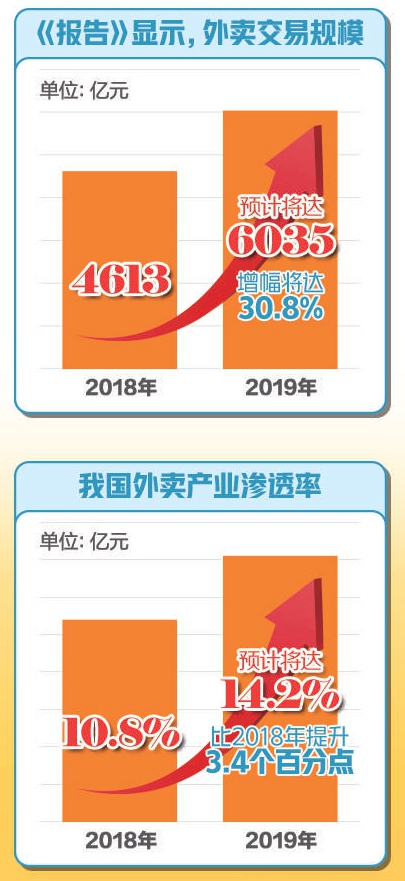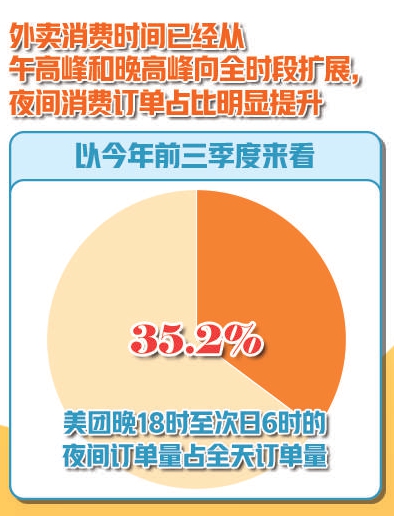How hot is the takeaway business in 2019, and the transaction volume is expected to increase by 30.8% over 600 billion.
Recently, Meituan Research Institute and China Hotel Association jointly released the "China Takeaway Industry Survey and Research Report". The "Report" shows that on the basis of the transaction volume of 461.30 billion yuan in 2018, the scale of takeaway in 2019 is expected to reach 603.50 billion yuan, an increase of 30.8%. The rapid development of the takeaway industry has injected new momentum into the entire catering industry.

Market size continues to increase
Data show that in the first three quarters of 2019, the transaction volume of China’s takeaway industry was 120 billion yuan, 143 billion yuan and 179 billion yuan respectively, an increase of 25.2% in the third quarter. At the same time, takeaway orders also continued to rise. Taking Meituan takeaway as an example, in the third quarter, Meituan takeaway’s daily average order volume reached 26.80 million orders, an increase of 38.1% year-on-year. The continuous growth of order volume shows that the role of takeaway in consumption is further highlighted, and the takeaway market still has huge growth potential.
With the continued rapid growth of the market scale, the penetration rate of the takeaway industry continues to increase. In 2018, the penetration rate of China’s takeaway industry was 10.8%, and by the third quarter of 2019, the penetration rate of the takeaway industry increased to 15.9%. It is expected that the penetration rate of the takeaway industry in 2019 will reach 14.2%, an increase of 3.4 percentage points compared with 2018.
From the perspective of consumer categories, meals are still the main consumer category for takeaway orders. While developing the habits of food and beverage takeaway users, it has also spawned many distribution scenarios and needs for non-food products. Today, with the continuous improvement of distribution efficiency, takeaway services have spilled over from food and beverage to life supermarkets, fresh fruits and vegetables, flowers and green plants, beauty, daily necessities, clothing, shoes and hats, and maternal and infant products, and even realized the OurHours delivery service. Meeting daily needs such as desserts and fruits, and festive needs such as cakes and flowers through takeaway is also becoming a new consumption habit of the people.
Night economy is a barometer of urban vitality. Under the combined effect of factors such as more and more abundant takeaway categories, faster delivery, and merchants taking the initiative to extend business hours, takeaway consumption hours have expanded from noon and evening peaks to OurHours, and the proportion of nighttime consumption orders has increased significantly. In the first three quarters of this year, Meituan’s orders from 18:00 to 6:00 the next day accounted for 35.2% of the day’s orders.
The leap from catering to non-catering is an important reason for the rapid growth of the takeaway industry. Wang Hongtao, deputy secretary-general of the China Chain Store Association, believes that thanks to technological upgrades and multi-scenario leapfrogging, restaurant information, evaluation and transactions continue to migrate to the Internet and mobile phones, making more and more new consumer demand possible, and jointly promoting the development and growth of the takeaway industry.

Ecological boundaries continue to expand
"In recent years, under the trend of technological development and consumption upgrading, takeaway is being upgraded from a new model to a new format." Lai Youwei, director of Meituan Research Institute, analyzed that takeaway is being upgraded from an "online channel" of catering to a necessary means for catering companies to improve their business capabilities.
For example, for China’s time-honored brands such as Qingfeng Baozi Shop and Huguosi Snacks, launching takeaway services is not an easy task.
"Huguosi snacks have always been mainly store food, and at first they maintained a very cautious attitude towards the new business of Internet takeaway. It was not until many young people called to inquire whether they could deliver takeout that they chose to launch the takeout service." Cao Shuqin, general manager of Beijing Huatian Jingyun Huguosi Catering Management Co., Ltd., told the Economic Daily-China Economic Network reporter that the biggest surprise of the takeaway business is to expand the coverage of stores and tap a lot of wold-be users. According to statistics, Huguosi snack takeaway has increased from about 2% of revenue to 12%.
In the rapid development of the takeaway industry, there are also many new trends. For example, reasonable meal matching is one of them. According to statistics, in the first three quarters of 2019, Meituan takeaway light food orders increased by 102% year-on-year, and light food is being welcomed by more and more consumers as a healthy way of eating. In this regard, Wang Puzhong, senior vice president of Meituan and president of the home business group, said that on the one hand, Meituan cooperates with the government, media, professional institutions, etc. to aggregate professional nutrition and health knowledge, and on the other hand, strengthens the popularization of knowledge about healthy catering through business guidance, and promotes the vigorous development of the supply of light food, healthy meals, and children’s meals for diverse groups.
"After years of development, takeaway is becoming an OurHours, cross-category consumption scenario, bringing dividends to the catering and retail industries." Lai Youwei said that takeaway is based on users’ real-time insights and driven by big data. It connects online and offline consumption scenarios around the local life service platform. It realizes closed-loop transactions online and completes transaction performance through instant delivery offline, thus providing more users with one-stop services from demand initiation to product acceptance.

The potential of the industry remains to be unlocked
The continuous and rapid growth of the takeaway industry has not only facilitated people’s lives, but also promoted the online and offline integration of the catering industry in our country, broadened the consumer application scenarios, and created a large number of job opportunities represented by takeaway riders, takeaway distribution station managers, takeaway side dishes personnel, takeaway operation planners, and online restaurant decorators.
"It can be said that China’s takeaway industry still has great potential for the development of new formats." Wang Hongtao said that on the one hand, because our country’s market is very large, especially the lower-tier market still has a lot of room for development; on the other hand, with the development of Internet technology, takeout will gradually realize intelligence, personalization and specialization, which will be a huge increase in consumption.
A set of data also fully confirms this view. According to statistics, at present, the number of takeaway users only accounts for 49% of the total number of Internet users, and the restaurants connected to the Internet catering service platform only account for about 40% of the total number of restaurants in our country. Many Midwestern regions and third- and fourth-tier cities have just started takeaway business.
With the increasingly fierce competition, the difficulty of obtaining customers has become a major problem plaguing many catering companies. Industry experts say that catering companies should unblock online and offline channels, integrate online and offline resources, and create an integrated marketing plan that covers more scenarios.
"In the past five years, the food delivery ecosystem has been expanding, forming an ecosystem that connects users, merchants and distribution on a platform basis, radiating supply chains, shared kitchens, food delivery operations and other diversified services." Wang Puzhong analyzed that in the next five years, Meituan will help millions of merchants to build "next-generation stores".
The so-called "next-generation store" is to upgrade the original store-based stores to stores with both online and offline operation capabilities and service capabilities through software and hardware transformation and iterative management models. In this process, takeaway platforms and service providers can provide merchants with a series of digital capabilities, and merchants can focus more on the main position of catering management, that is, to make the store better and stronger.
It is worth noting that while the takeaway industry has achieved prosperity and development, there are also some hidden dangers that cannot be ignored. "Providing consumers with a safer and more assured dining experience is the cornerstone of the healthy and sustainable development of the takeaway industry." Lai Youwei said that the governance of online catering should adhere to the basic principle of "online and offline consistency". In particular, small catering, which mainly focuses on snacks and fast food, and the price is close to the people, should implement record registration management and allow online operation. This is not only conducive to the full coverage of offline catering license management, but also conducive to the full coverage of online catering license management. (Ji Leilei, reporter of Economic Daily-China Economic Network)